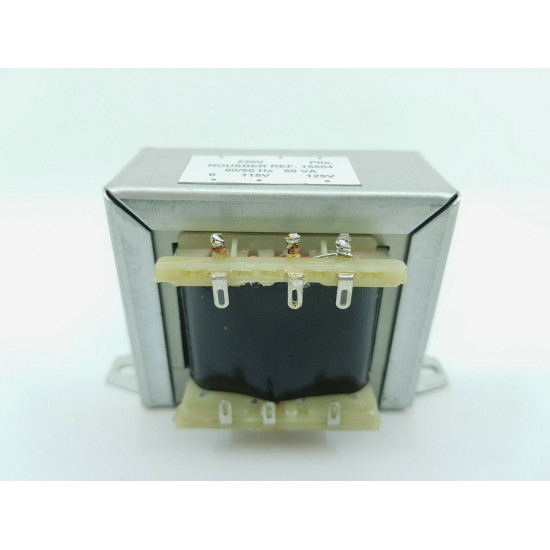- PESO: 1210 gr
Fabricado en España, cobre de alta calidad. El precio es por unidad. Disponemos de más transformadores de diferentes capacidades.
Para mas informacion, consulte la fotografia. Ref. R20-15504
Transformador de aislamiento o separador de red.
Todo transformador eléctrico, sea reductor o elevador de voltaje, tiene
la particularidad de transferir energía entre sus bobinados, por
inducción electromagnética y sin que exista entre ellos, conexión
eléctrica alguna (excepto los auto-transformadores). Por tanto, un
transformador ofrece una aislación entre los circuitos conectados en el
bobinado primario y los conectados al secundario.
Esta particularidad, resulta útil, como medida de seguridad, cuando se requiere alimentar un aparato (eléctrico o electrónico) desde la red eléctrica, pero sin que exista conexión directa con ella, para proteger la integridad física de quienes deban entrar en contacto con sus circuitos. Por ejemplo, cuando el técnico reparador debe trabajar en aparatos, cuyos circuitos electrónicos están directamente alimentados desde la red eléctrica. Comúnmente llamados: "circuitos hot", "chasis caliente", "chasis vivo", etc. y en el caso de los aparatos de radio antiguos los denominados “universales”, en los que una de las fases de la red esta conectada al chasis.
Entre la red eléctrica domiciliaria de 230 VAC y tierra, existe siempre una diferencia de potencial eléctrico que puede alcanzar hasta el 100% del voltaje de línea. El cuerpo humano, por estar compuesto en gran parte por agua, es un buen conductor de la electricidad. Entrar en contacto con la red eléctrica o con cualquier circuito conectado directamente a ella, puede ocasionar que esa diferencia de potencial o voltaje existente entre la línea y tierra produzca una corriente eléctrica a través del cuerpo, que puede llegar a ser letal.
Al colocar un transformador aislador, entre la red eléctrica y el
aparato o circuito que se esté manipulando, este recibirá el mismo
voltaje requerido para su funcionamiento pero estará aislado de la
diferencia de potencial existente entre la línea de distribución
eléctrica y tierra, evitando de esa manera, el peligro de sufrir una
descarga al entrar en contacto con el.
Esta medida de seguridad, también permite proteger los circuitos del
aparato y los instrumentos de prueba alimentados de la red eléctrica que
deban conectarse a él durante el trabajo de reparación, por ejemplo
osciloscopio, generador de señal, etc. Pues por lo general estos
instrumentos suelen tener una conexión a tierra a través del
tomacorriente, y al conectar su cable de prueba al chasis "vivo"
(conectado directamente a la red eléctrica), produce un cortocircuito
que puede ocasionar severos daños en los componentes y circuitos
electrónicos del equipo en reparación y del instrumento de prueba
involucrado.
Nuestros transformadores con bobinados concéntricos, van provistos además, de una pantalla electrostática entre primario y secundario, compuesta por una cinta de cobre de 0,1mm del mismo ancho que ocupa el bobinado.
Esta pantalla deriva a masa una posible fuga entre los bobinados primario y secundario además de eliminar algunas de las interferencias de la red.
Como el secundario ofrece la posibilidad de disponer de tensiones de 115 y 125v, sirve para adaptar a la tensión de red actual la mayoría de aparatos antiguos que no disponen de transformador de alimentación.
Isolation transformer or network separator.
Every electrical transformer, be it voltage reducer or booster, has the
peculiarity of transferring energy between its windings, by
electromagnetic induction and without any electrical connection between
them (except auto-transformers). Thus, a transformer provides isolation
between circuits connected in the primary winding and those connected to
the secondary.
This particularity is useful, as a safety measure, when it is necessary to supply an appliance (electrical or electronic) from the electrical network, but without a direct connection to it, to protect the physical integrity of those who must come into contact with its circuits. . For example, when the repair technician must work on devices, whose electronic circuits are directly fed from the electrical network. Commonly called: "hot circuits", "hot chassis", "live chassis", etc. and in the case of old radio devices, the so-called “universal” ones, in which one of the phases of the network is connected to the chassis.
Between the 230 VAC household electrical network and ground, there is always an electrical potential difference that can reach up to 100% of the line voltage. The human body, being largely made up of water, is a good conductor of electricity. Coming in contact with the electrical network or with any circuit connected directly to it, can cause that difference in potential or voltage existing between the line and ground to produce an electrical current through the body, which can reach be lethal.
By placing an isolating transformer between the electrical network and the device or circuit being manipulated, it will receive the same voltage required for its operation but it will be isolated from the potential difference between the electrical distribution line and ground, avoiding that way, the danger of shock when coming into contact with it.
This safety measure also makes it possible to protect the circuits of the device and the test instruments powered by the electrical network that must be connected to it during repair work, for example oscilloscope, signal generator, etc. As these instruments usually have a ground connection through the socket, and when connecting their test cable to the "live" chassis (connected directly to the electrical network), it produces a short circuit that can cause severe damage to the components and electronic circuits of the equipment under repair and of the test instrument involved.
Our transformers with concentric windings are also provided with an electrostatic screen between primary and secondary, composed of a 0.1mm copper tape of the same width as the winding.
This screen ground a possible leak between the primary and secondary windings in addition to eliminating some of the network interference.
As the secondary offers the possibility of having voltages of 115 and 125v, it is used to adapt most old appliances that do not have a power transformer to the current mains voltage.


